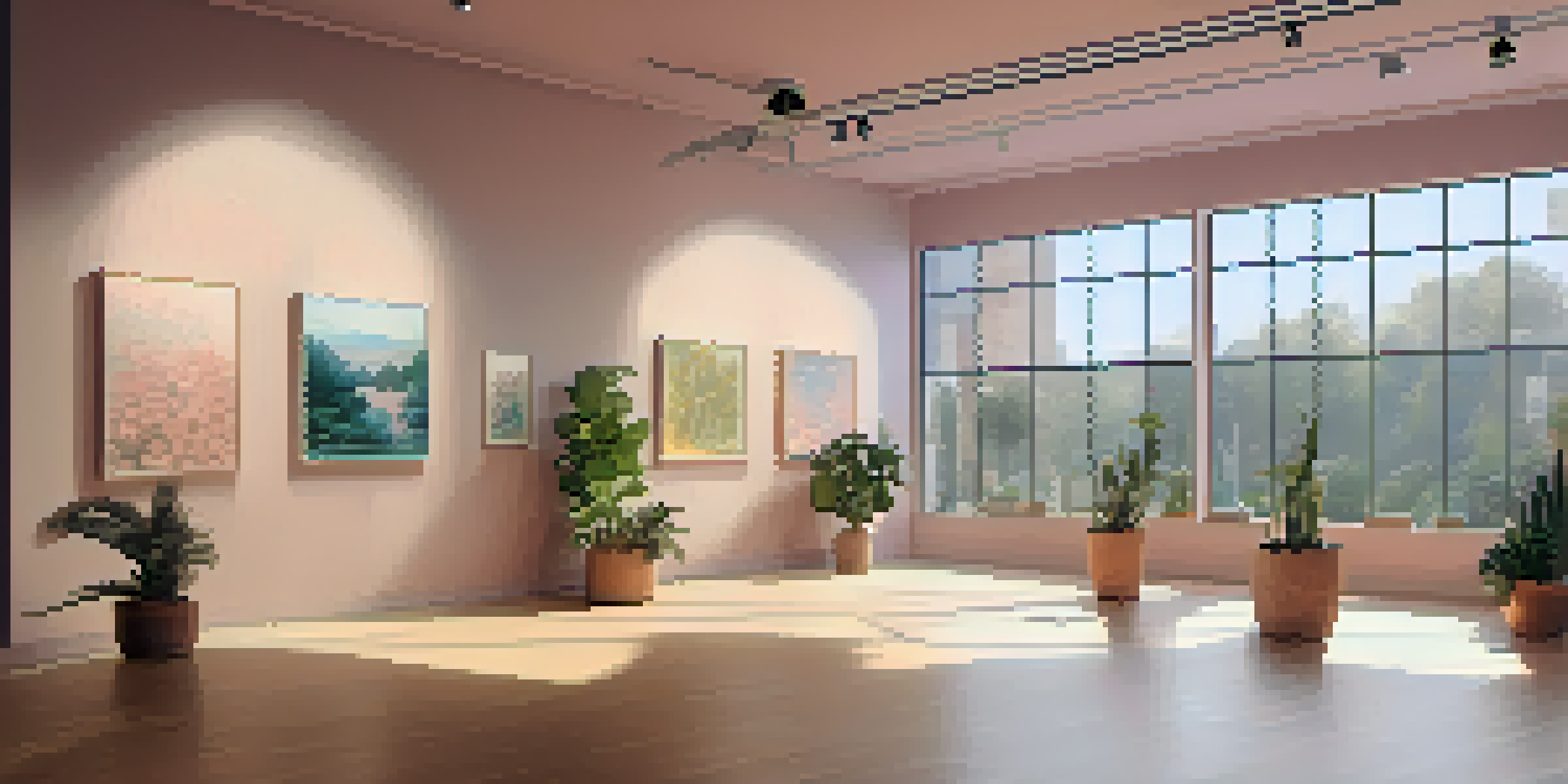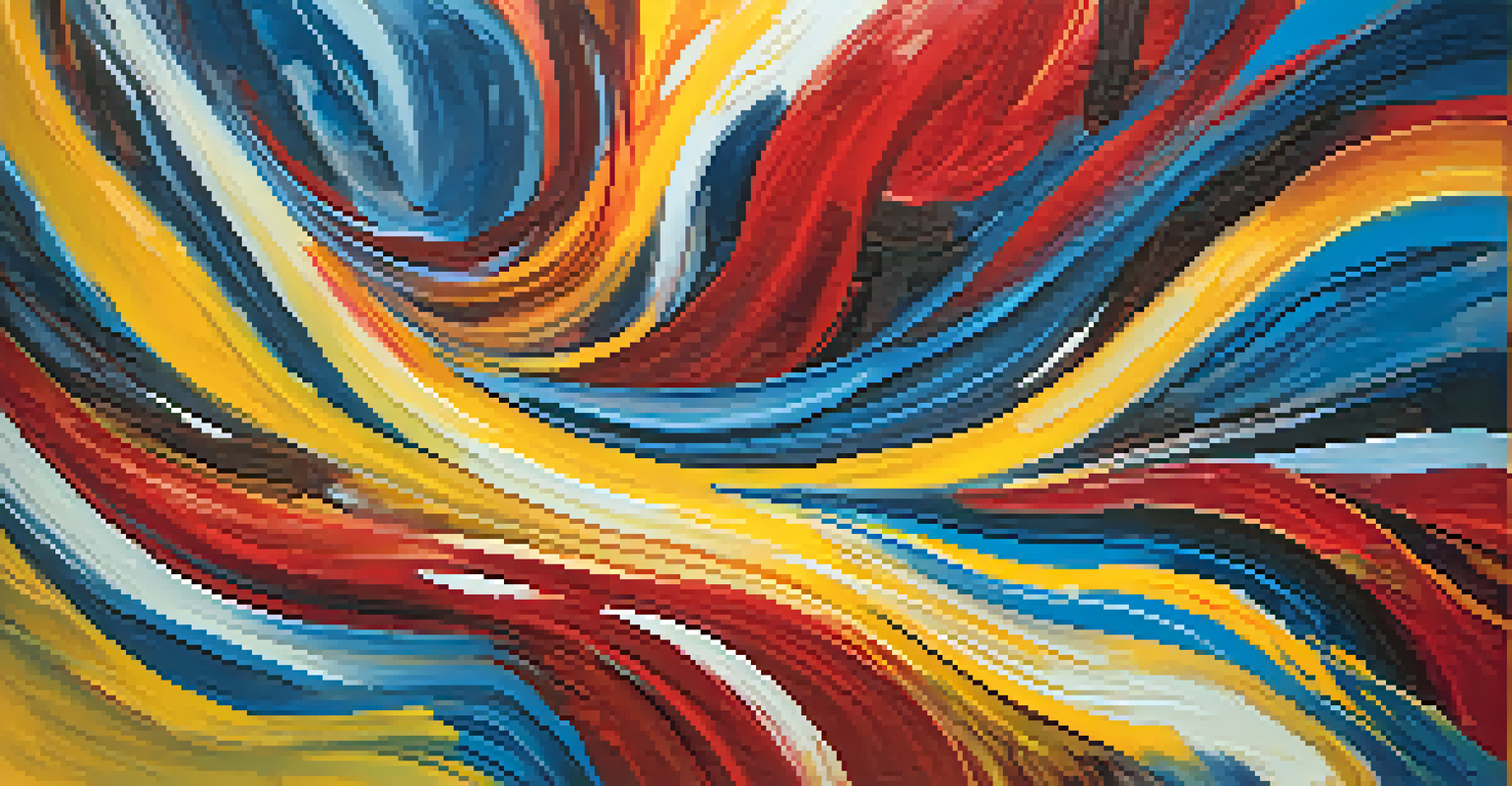Art Exhibitions: A Platform for Mental Health Awareness

The Intersection of Art and Mental Health
Art has long been a medium for self-expression, but its connection to mental health awareness is becoming increasingly recognized. Exhibitions provide a space for artists to share their experiences, thoughts, and feelings related to mental health challenges. By showcasing these narratives, they help demystify mental health issues and encourage open discussions.
Art is not freedom from discipline, but disciplined freedom.
Many artists use their work as a therapeutic outlet, transforming personal struggles into relatable pieces. This not only allows them to process their emotions but also resonates with viewers who may share similar experiences. Such connections can be powerful, fostering empathy and understanding among audiences.
Moreover, art can serve as a catalyst for change, challenging societal stigma surrounding mental health. When people engage with art that addresses these topics, it can spark conversations and promote awareness, encouraging a more compassionate society.
Creating Safe Spaces Through Exhibitions
Art exhibitions can serve as safe havens for individuals grappling with mental health issues. These spaces often invite visitors to reflect, connect, and find solace in the artwork displayed. By providing a supportive environment, they can help alleviate feelings of isolation and promote healing.

Many exhibitions incorporate interactive elements, inviting attendees to engage with the art on a deeper level. This interaction allows for personal reflection and can even inspire individuals to share their own stories. When visitors feel comfortable expressing themselves, it reinforces the idea that they are not alone in their struggles.
Art as a Dialogue for Mental Health
Art exhibitions create a space for open discussions about mental health, helping to demystify challenges and foster empathy.
Furthermore, organizations often partner with mental health professionals to provide resources and support during these exhibitions. This creates a holistic experience that not only celebrates art but also prioritizes mental well-being, guiding attendees toward helpful resources.
Highlighting Artists with Mental Health Experiences
Many artists channel their mental health journeys into their work, creating pieces that resonate deeply with audiences. By highlighting these artists, exhibitions can shed light on the often-unseen battles individuals face. This representation is crucial in normalizing conversations about mental health.
The greatest healing therapy is friendship and love.
Exhibitions that focus on artists with lived experiences can also empower these creators, validating their struggles and triumphs. When their work is showcased, it not only opens doors for dialogue but also encourages other artists to share their stories without fear of judgment.
Such representation can inspire hope and resilience, demonstrating that healing is possible. Viewers may find solace in knowing that their favorite artists have navigated similar paths, reminding them that it’s okay to seek help and express vulnerability.
Art as a Tool for Community Engagement
Art exhibitions can foster community engagement, bringing people together to discuss mental health in a more approachable way. By creating a collective experience, these events encourage dialogue and help break down barriers. When individuals from various backgrounds come together, it enriches the conversation around mental health.
Community art projects often accompany these exhibitions, inviting participants to contribute their own expressions of mental health. This collaborative effort not only builds connections but also empowers individuals to share their stories in a supportive environment. It transforms art into a communal language that speaks to shared experiences.
Empowering Artists' Experiences
Showcasing work by artists with mental health experiences normalizes conversations and inspires others to share their stories.
Additionally, these engagements can lead to lasting changes within communities, promoting mental health resources and support systems. By working together, communities can create a culture of understanding and compassion towards mental health challenges.
The Role of Technology in Art Exhibitions
In today’s digital age, technology plays a significant role in expanding access to art exhibitions focused on mental health. Virtual galleries and online platforms allow people from all walks of life to experience these exhibitions, regardless of their physical location. This accessibility is particularly important for individuals who may feel uncomfortable attending in-person events.
Social media has also become a powerful tool for promoting mental health awareness through art. Artists can share their stories and artworks online, reaching a wider audience and sparking conversations. This digital engagement can create a sense of community, as followers share their own experiences and support one another.
Moreover, technology can enhance the exhibition experience itself, incorporating interactive elements that engage visitors on multiple levels. From virtual reality installations to mobile apps that provide additional context, technology can deepen understanding and make the art more impactful.
The Future of Art Exhibitions and Mental Health Awareness
As society continues to prioritize mental health, the future of art exhibitions looks promising. There is a growing recognition of the importance of mental well-being, and art provides a unique platform to address these issues creatively. Artists, curators, and mental health advocates are collaborating more than ever to create meaningful exhibitions.
Future exhibitions may explore even more diverse perspectives on mental health, showcasing a wider range of experiences and cultural backgrounds. This inclusivity can help further break down stigma and promote a richer dialogue around mental health challenges faced by various communities.
Community Engagement through Art
Art exhibitions promote community connections, encouraging collective dialogue and support around mental health issues.
Additionally, we can anticipate more innovative formats that blend traditional art with technology, enhancing engagement and accessibility. As art continues to evolve, so too will its role in advocating for mental health awareness, making it an essential part of our collective journey toward understanding and support.
Conclusion: The Transformative Power of Art
In conclusion, art exhibitions hold immense potential for raising awareness about mental health. By providing a platform for artists and creating spaces for conversation, they foster understanding and compassion. The transformative power of art can heal, connect, and inspire, making a significant impact on individuals and communities alike.
As we continue to explore the intersection of art and mental health, it’s essential to support these initiatives. Whether through attending exhibitions, sharing experiences, or simply engaging with art, everyone can contribute to this vital conversation. Every action counts in creating a society that prioritizes mental well-being.

Ultimately, art serves as a reminder that we are not alone in our struggles. It invites us to share our stories, listen to others, and build a community rooted in empathy and understanding. Together, through art, we can shine a light on mental health and foster a more compassionate world.